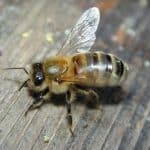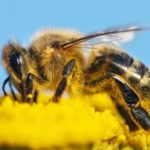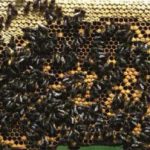Its size can vary a lot, from 2 mm to 4 centimeters.They have two eyes composed of many hexagonal facets and three simple eyes.Normally it, it has a black brown body covered with gray or brown hairs.It has two pairs of colored wings with dark veins that allow it to fly in all directions like a helicopter.It has six hairy and brown legs.
Latin Name: Apis Mellifera
Description:Her size can vary a lot, from 2 mm to 4 centimeters.They have two eyes composed of many hexagonal facets and three simple eyes.Normally she, she has a brown-black body covered with gray or brown hairs.She has two pairs of colored wings with dark veins that allow her to fly in all directions like a helicopter.She has six hairy and brown legs.Her eyes allow her to see even behind her. Her antennae are used to pick up smells.She has a proboscis to suck nectar from the bottom of flowersand two mandibles that are used to manipulate wax and move objects.The bee has a retractable stinger to defend herself or the nest or hive.
Reproduction:There are more than 20,000 species of bees in the world and more are still being discovered. Some are solitary, others are gregarious ( live in groups).Normally, the bee makes its nests in trees or in the ground.The swarm is the name given to the nest of the bee and it is made of hexagonal cells of wax superimposed and it is often surrounded by cellulose ( paper maché). In swarms, the queen is in charge of everything.The male serves only one purpose: to fertilize the queens.The queen lives about five years and she lays non-stop, nearly 1500 eggs every 24 hours.When the nest is at maximum capacity of bees, one of the newly laid queenspars with workers and males to go form another swarm elsewhere.
Prevention:The bee does not attack unless you threaten it or the nest.The bee has a retractable stinger that has tips that spread out into the flesh preventing the stinger from coming out. The bee dies once it stings, so it doesn’t sting for nothing.If you are stung, remove the stinger with tweezers and disinfect the sting.Humans use bees to pollinate plants in crops, so it’s normal to see large numbers of bees near fields.Check to see if you see any hives set up near the area where you see a large concentration of bees. You can also check with the growers who own the fields you are in. If it is not a « domestic » bee, you can try to find the nest. Do not attempt to remove the nest yourself, as the sting of several bees can be dangerous or even fatal.




